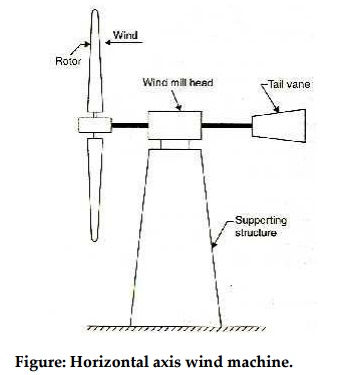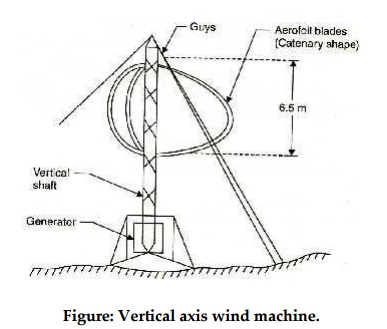Wind-Electric Generating power plant
Figure shows the various parts of a wind-electric generating power plant. These are:
1. Wind turbine or rotor.
2. Wind mill head –it houses speed increaser, drive shaft, clutch, coupling etc.

Figure: Wind-Electric generating power plant
3. Electric generator.
4. Supporting structure.
· The most important component is the rotor. For an effective utilization, all components should be properly designed and matched with the rest of the components.
· The wind mill head performs the following functions:
(i) It supports the rotor housing and the rotor bearings.
(ii)It also houses any control mechanism incorporated like changing the pitch of the blades for safety devices and tail vane to orient the rotor to face the wind, the latter is facilitated by mounting it on the top of the supporting structure on suitable bearings.
· The wind turbine may be located either unwind or downwind of the power. In the unwind location the wind encounters the turbine before reaching the tower. Downwind rotors are generally preferred especially for the large aerogenerators.
· The supporting structure is designed to withstand the wind load during gusts. Its type and height is related to cost and transmission system incorporated. Horizontal axis wind turbines are mounted on towers so as to be above the level of turbulence and other ground related effects.
Types of Wind Machines
Wind machines (aerogenerators) are generally classified as follows:
1. Horizontal axis wind machines.
2. Vertical axis wind machines.
Horizontal axis wind machines. Figure shows a schematic arrangement of horizontal axis machine. Although the common wind turbine with horizontal axis is simple in principle yet the design of a complete system, especially a large one that would produce electric power economically, is complex. It is of paramount importance’sthat the components like rotor, transmission, generator and tower should not only be as efficient as possible but they must also function effectively in combination.

Figure: Horizontal axis wind machine.
Vertical axis wind machines. Figure shows vertical axis type wind machine. One of the main advantages of vertical axis rotors is that they do not have to be turned into the windstream as the wind direction changes. Because their operation is independent of wind direction, vertical axis machine are called panemones.

Figure: Vertical axis wind machine.

